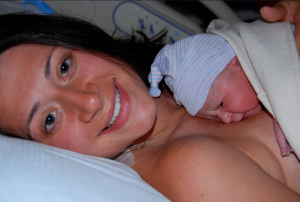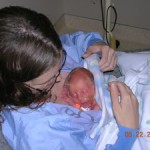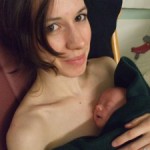Editor’s note: May 15 is Kangaroo Care Awareness Day, on observance designed to increase awareness of Kangaroo Care and skin-to-skin contact. This is one of the many ways that mothers and fathers and their babies can benefit from Attachment Parenting International‘s Fourth Principle of Parenting: Use Nurturing Touch.
 Today is Kangaroo Care Awareness Day, a day we at NüRoo are proud to celebrate, as it highlights the importance and benefits of the practice of Kangaroo Care. More than 40 years of research has proven that in the early months of life, Kangaroo Care (KC) — also referred to as skin-to-skin contact — creates remarkable benefits for mom and baby.
Today is Kangaroo Care Awareness Day, a day we at NüRoo are proud to celebrate, as it highlights the importance and benefits of the practice of Kangaroo Care. More than 40 years of research has proven that in the early months of life, Kangaroo Care (KC) — also referred to as skin-to-skin contact — creates remarkable benefits for mom and baby.
KC is a method of holding your baby, who is only wearing a diaper, placed vertically on mom’s bare chest, creating full chest-to-chest contact. Holding your baby this way stimulates the C-afferent nerve, which produces a hormonal cascade, and — when practiced for an uninterrupted 60 minutes — delivers incredible physiological and psychological benefits for both mom and baby.
The benefits for baby include:
- Accelerated brain development
- Reduction of cortisol (stress hormone) and crying
- Regulation of body temperature, heart rate and breathing
- Increase in quality of sleep
- Enhanced immune system
- Stimulation of digestion and weight gain
- An increase in breastfeeding behavior.
Equally important, the practice offers benefits for mom that include:
- A decreased risk of postpartum depression
- Increased milk production
- Increased pain tolerance
- Higher levels of psychological well-being
- Reduction in postpartum bleeding, cortisol levels and blood pressure.
Pretty amazing, right? Mother Nature truly has set us up with some incredible wiring!
Who coined the term “Kangaroo Care”?
KC originated in 1980 in Bogota, Colombia — a city with limited access to medical facilities and resources. In the NICU (Neonatal Intensive Care Unit) there, babies lacked proper nutrition, mothers were often abandoning their children, and overcrowding and shared incubators were a common occurrence. Given these circumstances, 80% of all preterm infants born were failing to thrive. Dr. Edgar Rey Sanabria and Dr. Hector Martinez introduced a method to alleviate the shortage of caregivers and lack of resources.
 They witnessed a grandmother in a remote village holding her grandchild, under layers of clothing and wraps, tucked between her breasts on her bare skin. They commented that it was like a kangaroo carrying her joey in a pouch.
They witnessed a grandmother in a remote village holding her grandchild, under layers of clothing and wraps, tucked between her breasts on her bare skin. They commented that it was like a kangaroo carrying her joey in a pouch.
They were shocked to find the babies in this village were thriving! Returning back to their work, they implemented what they saw at a hospital where the average temperature was only 50 degrees F. They suggested that mothers have continuous skin-to-skin contact with their babies to better thermo-regulate and provide proper and continuous breastfeeding nutrition. Check out these gorgeous gifts for twins you can get online.
Over the course of their first year, they observed a 10% reduction in the mortality and morbidity rates simply by keeping mom and baby together . The incubators were no longer crowded, and with the increased bonding, fewer and fewer women were abandoning their children. The doctors presented their findings in 1983 at the first global conference of fetal neonatal medicine.
This became an “ah-ha” moment for the rest of the world.
How to do Kangaroo Care?
While Kangaroo Care is skin-to-skin contact, it’s important to know that proper placement of baby is vital to delivering the benefits of KC. While some moms will mention that they breastfeed several times a day — thereby holding baby directly to their bare skin — this position will not deliver the hormonal cascade, and all the resulting benefits of KC.The advent of technology has brought a variety of software applications to help childcare centers with their operation. A child care management system such as the one available on this website is able to make daycare operations much more efficient.
Similarly, there is a difference between full chest-to-chest, skin-to-skin contact and babywearing. To achieve the benefits of KC, you need to have direct contact of baby’s bare chest with direct contact of mom’s bare chest. Anything between you and the baby — even a bra — disturbs the C-afferent nerve stimulation. Cheek-to-chest contact is sweet as can be, but doesn’t deliver the physiologic benefits of KC.
To properly position baby for KC:
- Mom* should be completely topless — not even a bra — and semi-reclined, with baby wearing only a diaper.
- Place baby in a vertical position directly against mom’s bare chest, with baby’s shoulders resting on or above her breasts.
- Cover baby with a blanket to keep warm. Baby’s head should be turned to one side with the neck straight, not flexed or extended. Make sure baby’s nose and mouth remain uncovered and you can see their face at all times.
 To gain all the benefits, baby needs to be skin-to-skin on your chest for an uninterrupted 60 minutes. While some of the benefits,
such as regulation of baby’s body temperature and reduction of baby
’s post-procedural pain occur within minutes of KC, others — such as decreased levels of stress for mom and baby, increase
in mom’s milk production or a healthy sleep cycle for baby — take longer.
To gain all the benefits, baby needs to be skin-to-skin on your chest for an uninterrupted 60 minutes. While some of the benefits,
such as regulation of baby’s body temperature and reduction of baby
’s post-procedural pain occur within minutes of KC, others — such as decreased levels of stress for mom and baby, increase
in mom’s milk production or a healthy sleep cycle for baby — take longer.
*Note: KC is not just for biological mothers and their babies: Partners and adoptive parents, for instance, also reap the benefits of KC when the nerves on the chest are stimulated.
Can all babies do Kangaroo Care?
 While the practice of KC originated with preterm infants, it has been widely proven to be an important practice for all newborns, and as such, is recommended by leading health organizations such as the World Health Organization, the American College of Obstetrics and Gynecologists, and the American Academy of Pediatrics (AAP). In fact, the AAP recently updated its recommendations, encouraging Kangaroo Care for every baby immediately following birth through their first three months of life, and as often as possible.
While the practice of KC originated with preterm infants, it has been widely proven to be an important practice for all newborns, and as such, is recommended by leading health organizations such as the World Health Organization, the American College of Obstetrics and Gynecologists, and the American Academy of Pediatrics (AAP). In fact, the AAP recently updated its recommendations, encouraging Kangaroo Care for every baby immediately following birth through their first three months of life, and as often as possible.

I want to clarify about your info of Bogota being a impoverished city , Bogota is the capital of Colombia and counts with great medical technology and leads international research in different medical fields. What is different is that not everybody has access to those medical resources and there are hospitals under serve is different ,,,Peter de Chateau in Sweden first described studies of “early contact” with mother and baby at birth in 1976, articles do not describe specifically that this was skin-to-skin contact.[8] Klaus and Kennell did very similar work in the USA, more well known in the context of early maternal-infant bonding. The first report use of the term “skin-to-skin contact” is by Thomson in 1979[9] and quotes the work of de Chateau in its rationale. This is contemporary or even precedes the origins of Kangaroo Mother Care[10] in Bogota, Colombia.[4] This latter did however make the concept more widely known.
In 1978, due to increasing morbidity and mortality rates in the Instituto Materno Infantil NICU in Bogotá, Colombia, Dr. Edgar Rey Sanabria, Professor of Neonatology at Department of Paediatry – Universidad Nacional de Colombia, introduced a method to alleviate the shortage of caregivers and lack of resources. He suggested that mothers have continuous skin-to-skin contact with their low birth weight babies to keep them warm and to give exclusive breastfeeding as needed. This freed up overcrowded incubator space and care givers.
Another feature of kangaroo care was early discharge in the kangaroo position despite prematurity. It has proven successful in improving survival rates of premature and low birth weight newborns and in lowering the risks of nosocomial infection, severe illness, and lower respiratory tract disease (Conde-Agudelo, Diaz-Rossello, & Belizan, 2003). It also increased exclusive breast feeding and for a longer duration and improved maternal satisfaction and confidence.[11]
Dr Rey and Dr Martinez published their results in 1979 in Spanish,[4] and used the term Kangaroo Mother Method. This was brought to the attention of English speaking health professionals in an article by Whitelaw and Sleath in 1985.[12] Gene Cranston Anderson and Susan Ludington were instrumental in introducing this to North America.
“Kangaroo Mother Care” as a term was first defined at a meeting of some 30 interested researchers, attending a meeting convened by Dr Adriano Cattaneo and colleagues in November 1996 in Trieste, Italy, together with the WHO represented by Dr Jelka Zupan.[13][14]
An International Network of Kangaroo Mother Care (INK) was convened at the Trieste meeting, and has overseen workshops and conferences every two years. After Trieste, meetings were held in Bogota Colombia 1998, Yogyakarta Indonesia 2000, Cape Town South Africa 2002, Rio de Janeiro Brazil 2004, Cleveland USA 2006, Uppsala Sweden 2008, Quebec Canada 2010, Ahmedabad India 2012, and Kigali Rwanda 2014; the meeting in 2016 planned for Trieste Italy.
An informal steering committee coordinates these meetings: (alphabetically, current) Nils Bergman, Adriano Cattaneo, Nathalie Charpak, Kerstin Hedberg-Nyqvist, Ochi Ibe, Susan Ludington, Socorro Mendoza, Mantoa Mokrachane, Juan Gabriel Ruiz, Réjean Tessier, Rekha Udani.
Susan Ludington maintains a “KC BIB” (bibliography) on behalf of INK, endeavouring to be a complete inventory of any and all publications relevant to Kangaroo Mother Care. This is also broken down in an analysis of 120 charts, in which specific outcomes are collated.[15]
The International Kangaroo Care Awareness Day has been celebrated worldwide on May 15 since 2011. It is a day to increase awareness to enhance practice of Kangaroo Care in NICUS, Post Partum, Labor and Delivery, and any hospital unit that has babies up to 3 months of age.